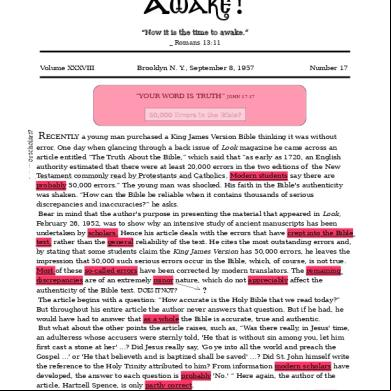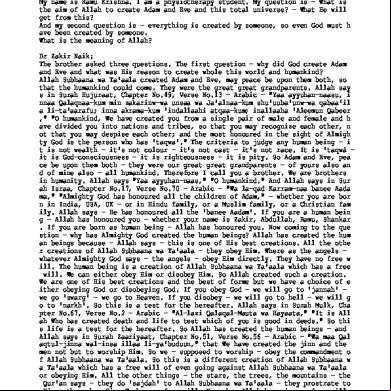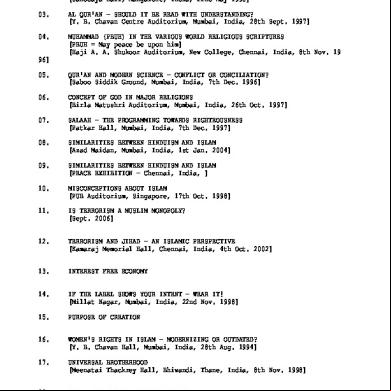50,000 Errors In The Bible 72v55
This document was ed by and they confirmed that they have the permission to share it. If you are author or own the copyright of this book, please report to us by using this report form. Report l4457
Overview 6h3y3j
& View 50,000 Errors In The Bible as PDF for free.
More details h6z72
- Words: 1,165
- Pages: 3
AWAKE!
“Now it is the time to awake.” _ Romans 13:11
Volume XXXVIII
Brooklyn N. Y., September 8, 1957
“YOUR WORD IS TRUTH”
Number 17
JOHN 17:17
or scholars?
50,000 Errors in the Bible?
RECENTLY a young man purchased a King James Version Bible thinking it was without
error. One day when glancing through a back issue of Look magazine he came across an article entitled “The Truth About the Bible,” which said that “as early as 1720, an English authority estimated that there were at least 20,000 errors in the two editions of the New Testament commonly read by Protestants and Catholics. Modern students say there are probably 50,000 errors.” The young man was shocked. His faith in the Bible's authenticity was shaken. “How can the Bible be reliable when it contains thousands of serious discrepancies and inaccuracies?” he asks. Bear in mind that the author's purpose in presenting the material that appeared in Look, February 26, 1952, was to show why an intensive study of ancient manuscripts has been undertaken by scholars. Hence his article deals with the errors that have crept into the Bible text, rather than the general reliability of the text. He cites the most outstanding errors and, by stating that some students claim the King James Version has 50,000 errors, he leaves the impression that 50,000 such serious errors occur in the Bible, which, of course, is not true. Most of these so-called errors have been corrected by modern translators. The remaining discrepancies are of an extremely minor nature, which do not appreciably affect the authenticity of the Bible text. DOES IT NOT? ? The article begins with a question: “How accurate is the Holy Bible that we read today?” But throughout his entire article the author never answers that question. But if he had, he would have had to answer that as a whole the Bible is accurate, true and authentic. But what about the other points the article raises, such as, “Was there really, in Jesus' time, an adulteress whose accs were sternly told, 'He that is without sin among you, let him first cast a stone at her' …? Did Jesus really say, 'Go ye into all the world and preach the Gospel …' or 'He that believeth and is baptized shall be saved' …? Did St. John himself write the reference to the Holy Trinity attributed to him? From information modern scholars have developed, the answer to each question is probably 'No.' “ Here again, the author of the article, Hartzell Spence, is only partly correct. The age, “He that is without sin among you, let him first cast a stone at her” is not found in several of the older manuscripts of the Bible. The New World Translation of the
THE HOLY QUR'AN CONDEMNED IT 1400 YEARS AGO!
Bible sets aside the first eleven verses from the rest of the text of John chapter eight. It is given as a footnote, which shows that the Sinaitic manuscript, the Vatican MS. No. 1209 and the Sinaitic Syriac codex do not contain these words. Keep in mind that the Sinaitic and the Vatican No. 1209 manuscripts are two of the oldest in existence, dating from the fourth century. These verses are found in the Codex Bezae of the sixth century, the Latin Vulgate of the fourth and fifth centuries and the Jerusalem Syriac version of the sixth century. But since the oldest Greek manuscripts do not contain these verses their origin is doubtful, – John 8:7. What about the next point, “Did Jesus really say, 'Go ye into all the world and SEPTEMBER 8, 1957 25 preach the Gospel' ?” The author quotes from the last twelve verses of Mark chapter sixteen, which have long been challenged. The New World Translation sets apart those last verses from the general text. It shows that certain ancient manuscripts and versions of the Scriptures add a long conclusion, but that the Sinaitic, the Vatican No. 1209, the Sinaitic Syriac codex and the Armenian version, of the fourth and fifth centuries, do not contain this age and hence it is of doubtful authenticity. The author leaves the impression that the good news or gospel is not to be preached because this text containing such onition is not authentic. However, in several other places in God's Word this same onition is given, which ages are reliable. For instance, Matthew 24:14 (New World Trans.): “And this good news of the kingdom will be preached in all the inhabited earth for the purpose of a witness to all the nations, and then the accomplished end will come.” Also at Matthew 28:19 (New World Trans.) Jesus commands: “Go therefore and make disciples of people of all nations, baptizing them.” So other scriptures, besides this questionable one in Mark, prove that Christ's followers are to preach and baptize. What about this point: “Did St. John himself write the reference to the Holy Trinity attributed to him?” The scripture referred to is 1 John 5:7,8. In commenting on this text a Greek Scripture translator, Benjamin Wilson, writes in his The Emphatic Diaglott: “This text concerning the heavenly witness is not contained in any Greek manuscript which was written earlier than the fifteenth century. It is not cited by any of the Greek ecclesiastical writers; nor by any of the early Latin fathers, even when the subjects upon which they treated would naturally have led them to appeal to its authority. It is therefore evidently spurious.” The truthfulness of this statement is borne out by the fact that the modern translations (except Roman Catholic translations from the Latin versions) do not include the text. An extremely significant point is that most modern translations have already eliminated the errors to which this writer refers in his article. Notice that the twenty to fifty thousand errors are accredited to the “two editions of the New Testament commonly read by Protestants and Catholics.” Those would be the King James Version and the Catholic Douay Version, which were produced in 1611 and 1600 respectively. So they were both more than 300 years old. When these translations were made the koiné Greek in which the Bible was written was not so well understood as it is today. So those translators made errors in translation that have been corrected by modern scholars. Archaeologists also have contributed to Bible research by finding many ancient manuscripts of the Scriptures.
Bible errors have been eliminated to the point where the remaining minor discrepancies are negligible. Sir Frederic G. Kenyon, an outstanding English scholar, in his book The Bible and Archaeology, pages 288, 289, says: “The interval then between the dates of original composition and the earliest extant evidence becomes so small as to be in fact negligible, and the last foundation for any doubt that the Scriptures have come down to us substantially as they were written has now been removed.” The Bible is reliable and beyond all doubt is God's Word.
Transcription made by [email protected]
“Now it is the time to awake.” _ Romans 13:11
Volume XXXVIII
Brooklyn N. Y., September 8, 1957
“YOUR WORD IS TRUTH”
Number 17
JOHN 17:17
or scholars?
50,000 Errors in the Bible?
RECENTLY a young man purchased a King James Version Bible thinking it was without
error. One day when glancing through a back issue of Look magazine he came across an article entitled “The Truth About the Bible,” which said that “as early as 1720, an English authority estimated that there were at least 20,000 errors in the two editions of the New Testament commonly read by Protestants and Catholics. Modern students say there are probably 50,000 errors.” The young man was shocked. His faith in the Bible's authenticity was shaken. “How can the Bible be reliable when it contains thousands of serious discrepancies and inaccuracies?” he asks. Bear in mind that the author's purpose in presenting the material that appeared in Look, February 26, 1952, was to show why an intensive study of ancient manuscripts has been undertaken by scholars. Hence his article deals with the errors that have crept into the Bible text, rather than the general reliability of the text. He cites the most outstanding errors and, by stating that some students claim the King James Version has 50,000 errors, he leaves the impression that 50,000 such serious errors occur in the Bible, which, of course, is not true. Most of these so-called errors have been corrected by modern translators. The remaining discrepancies are of an extremely minor nature, which do not appreciably affect the authenticity of the Bible text. DOES IT NOT? ? The article begins with a question: “How accurate is the Holy Bible that we read today?” But throughout his entire article the author never answers that question. But if he had, he would have had to answer that as a whole the Bible is accurate, true and authentic. But what about the other points the article raises, such as, “Was there really, in Jesus' time, an adulteress whose accs were sternly told, 'He that is without sin among you, let him first cast a stone at her' …? Did Jesus really say, 'Go ye into all the world and preach the Gospel …' or 'He that believeth and is baptized shall be saved' …? Did St. John himself write the reference to the Holy Trinity attributed to him? From information modern scholars have developed, the answer to each question is probably 'No.' “ Here again, the author of the article, Hartzell Spence, is only partly correct. The age, “He that is without sin among you, let him first cast a stone at her” is not found in several of the older manuscripts of the Bible. The New World Translation of the
THE HOLY QUR'AN CONDEMNED IT 1400 YEARS AGO!
Bible sets aside the first eleven verses from the rest of the text of John chapter eight. It is given as a footnote, which shows that the Sinaitic manuscript, the Vatican MS. No. 1209 and the Sinaitic Syriac codex do not contain these words. Keep in mind that the Sinaitic and the Vatican No. 1209 manuscripts are two of the oldest in existence, dating from the fourth century. These verses are found in the Codex Bezae of the sixth century, the Latin Vulgate of the fourth and fifth centuries and the Jerusalem Syriac version of the sixth century. But since the oldest Greek manuscripts do not contain these verses their origin is doubtful, – John 8:7. What about the next point, “Did Jesus really say, 'Go ye into all the world and SEPTEMBER 8, 1957 25 preach the Gospel' ?” The author quotes from the last twelve verses of Mark chapter sixteen, which have long been challenged. The New World Translation sets apart those last verses from the general text. It shows that certain ancient manuscripts and versions of the Scriptures add a long conclusion, but that the Sinaitic, the Vatican No. 1209, the Sinaitic Syriac codex and the Armenian version, of the fourth and fifth centuries, do not contain this age and hence it is of doubtful authenticity. The author leaves the impression that the good news or gospel is not to be preached because this text containing such onition is not authentic. However, in several other places in God's Word this same onition is given, which ages are reliable. For instance, Matthew 24:14 (New World Trans.): “And this good news of the kingdom will be preached in all the inhabited earth for the purpose of a witness to all the nations, and then the accomplished end will come.” Also at Matthew 28:19 (New World Trans.) Jesus commands: “Go therefore and make disciples of people of all nations, baptizing them.” So other scriptures, besides this questionable one in Mark, prove that Christ's followers are to preach and baptize. What about this point: “Did St. John himself write the reference to the Holy Trinity attributed to him?” The scripture referred to is 1 John 5:7,8. In commenting on this text a Greek Scripture translator, Benjamin Wilson, writes in his The Emphatic Diaglott: “This text concerning the heavenly witness is not contained in any Greek manuscript which was written earlier than the fifteenth century. It is not cited by any of the Greek ecclesiastical writers; nor by any of the early Latin fathers, even when the subjects upon which they treated would naturally have led them to appeal to its authority. It is therefore evidently spurious.” The truthfulness of this statement is borne out by the fact that the modern translations (except Roman Catholic translations from the Latin versions) do not include the text. An extremely significant point is that most modern translations have already eliminated the errors to which this writer refers in his article. Notice that the twenty to fifty thousand errors are accredited to the “two editions of the New Testament commonly read by Protestants and Catholics.” Those would be the King James Version and the Catholic Douay Version, which were produced in 1611 and 1600 respectively. So they were both more than 300 years old. When these translations were made the koiné Greek in which the Bible was written was not so well understood as it is today. So those translators made errors in translation that have been corrected by modern scholars. Archaeologists also have contributed to Bible research by finding many ancient manuscripts of the Scriptures.
Bible errors have been eliminated to the point where the remaining minor discrepancies are negligible. Sir Frederic G. Kenyon, an outstanding English scholar, in his book The Bible and Archaeology, pages 288, 289, says: “The interval then between the dates of original composition and the earliest extant evidence becomes so small as to be in fact negligible, and the last foundation for any doubt that the Scriptures have come down to us substantially as they were written has now been removed.” The Bible is reliable and beyond all doubt is God's Word.
Transcription made by [email protected]










